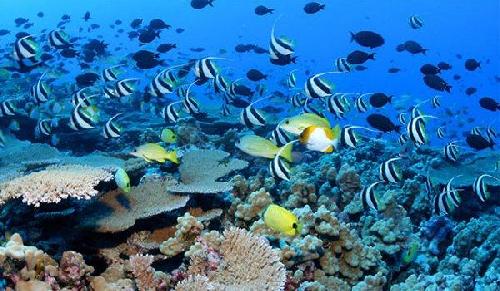Coral reefs are widely known for their stunning array of color, shape and forms of life, making them a model for extreme biodiversity. Hidden within the multitude of reef inhabitants, but no less important, is their genetic diversity-- variability in DNA that gives species the capacity for adaptation, speciation and resilience in the face of stress. Research published today by a team of scientists from the University of Hawai'i at Mānoa (UHM) School of Ocean and Earth Science and Technology, the University of California, Santa Barbara (UCSB), University of St. Andrews, and University of Melbourne discovered that large areas of intact coral reef with extensive live coral cover, not disturbed by humans or climate change, harbor the greatest amount of genetic diversity.
The team, led by Kimberly Selkoe, associate researcher at the UHM Hawai'i Institute of Marine Biology (HIMB) and UCSB, assessed genetic diversity from over 17,000 samples taken from 47 common reef-associated species across the Hawaiian Archipelago. With this work, the researchers uncovered a link between species diversity of an ecosystem and the genetic diversity encoded within the DNA of those species.
Genetic diversity is linked to adaptive capacity, extinction risk of species, and the overall functioning of ecosystems, so conservation strategies often call for preserving areas of high genetic diversity. However, prior to this study there was little direct data to guide debates such as whether many small versus one large marine reserve would be better to protect genetic resources. The study found that Papahānaumokuākea Marine National Monument (PMNM) safeguards the majority of Hawaiian reef biodiversity, but populations in the Main Hawaiian Islands (MHI) are genetically distinct and warrant additional protection.
 This image shows coral reef in the Northwestern Hawaiian Islands/ Papahānaumokuākea Marine National Monument teeming with fishes. Credit: James Watt, courtesy of PMNM/ NOAA
This image shows coral reef in the Northwestern Hawaiian Islands/ Papahānaumokuākea Marine National Monument teeming with fishes. Credit: James Watt, courtesy of PMNM/ NOAA
"Management of marine resources should be based on the best available science, and this study underscores the importance of protecting large areas of coral reef habitat," said Randall Kosaki, NOAA's Deputy Superintendent of Papahānaumokuākea. "Protecting biodiversity and ecosystem integrity is our primary goal."
"Our study provides support for campaigns such as the Big Ocean Initiative, that seek to protect large areas of healthy coral reef habitat," said Rob Toonen, research professor at HIMB and co-author of the study. "However, we also need a diversity of approaches to preserve marine biodiversity because one size simply does not fit all in conservation efforts."
The researchers found that genetic diversity varies across the inhabited MHI, extending the argument for targeted protection of reefs throughout the MHI. Notably, Hawai'i Island has the greatest amount of coral reef area, harbors the greatest proportion of genetic diversity, and serves a unique, and particularly influential role due to its large size at the margin of the chain. Nihoa and Ni'ihau, which sit at the transition between PMNM and the MHI, also stand out and warrant future research and protection due to intriguing combinations of high genetic divergence and unusual fish composition.
Genetic diversity is widely accepted as critical for adaptation to a changing climate. Although coral bleaching in Hawaii has been relatively rare over the past few decades by comparison to many other places in the Pacific, this stressor still exerts a large impact on the reef communities studied. Researchers found that areas which experienced the most frequent coral bleaching conditions also showed depressed levels of genetic diversity, not just for corals but for the entire community of fishes and other invertebrates associated with those habitats.
"This negative impact of thermal stress on genetic diversity suggests that climate change will compromise the adaptive capacity and genetic integrity of not just corals but the entire coral reef community," explained Selkoe.
Identifying features of the landscape that are associated with biodiversity hotspots is one of the key strategies for conservation. In the future, the team will follow up on intriguing evidence in the dataset that the same large-scale ecological rules that predict species diversity also predict genetic diversity.
"If these relationships can be confirmed and replicated elsewhere, DNA sampling may one day allow rapid assessment of species diversity and new metrics of resilience and adaptive capacity," explained Selkoe, also an associate at UCSB's National Center for Ecological Synthesis and Analysis and an adjunct professor at the campus's Bren School of Ecological Science & Management.
source: University of Hawaii at Manoa